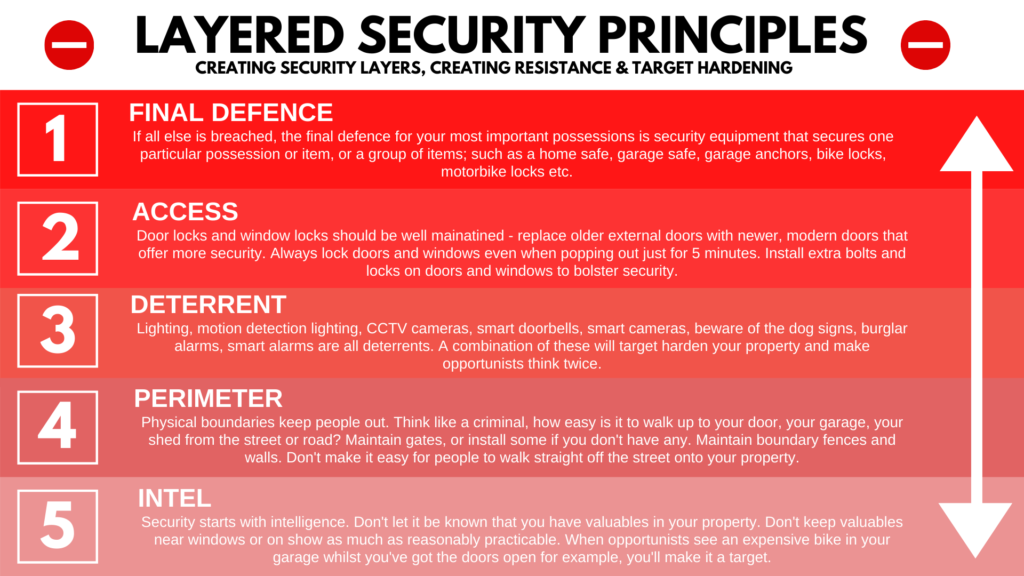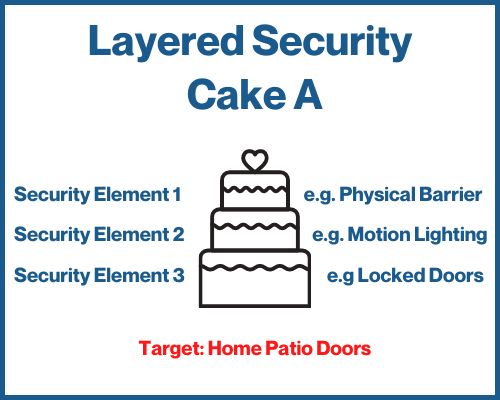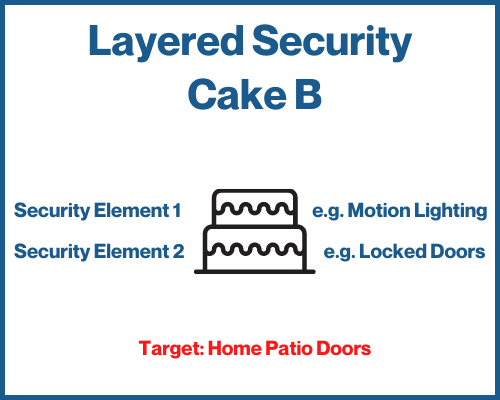Layered security is an approach to security where multiple security elements are implemented on top of each other to strengthen the overall security of an asset like a home.
The purpose of layered security is to strengthen overall security, providing backup functions and ensuring that there is no one single point of failure or vulnerability.
Below is a handy table of contents for easy navigation of this page.
Table of Contents
Layered Security
Here’s a detailed example of layered security. This can be applied to any security not just home security, with some small modifications.
Start at number 5 at the bottom.

Publishers: Please feel free to download this graphic and use on your own site – but do link back to this site or page.
Deter, Detect, Prevent,
Deter, detect and prevent is a central theme through security and layered security.
Some security measures will overlap into each other, but here’s some security measures and arrangements that fall into each category.
Deter
To deter is to stop any criminal activity from taking place in the first place.
In terms of home security, a deterrent can be anything from this list for example; physical barriers like gates at the front of the house, physical barriers like walls, fencing, gates stopping easy access to the back of a house, CCTV, signage, lighting.
See also: 75 Ways To Improve Home Security
Detect
Detection systems also blur into the deter category, especially if the detection is overt. Some examples of detection security measures are; CCTV cameras, fixed lighting or motion detection lighting, smart doorbells, burglar alarms, motion sensor alarms, window and door alarms, break glass or vibration alarms.
These systems will detect and alert you or anyone in the vicinity usually by audible warnings (like an alarm) or flashing lights – or in our modern day, smart enabled world, alerts to your mobile phone.
Prevent
To prevent is the last line of defence, and usually means that a criminal is close to gaining access to your property or valuables. In this list we have; locks and bolts on doors and windows, window bars, security bars, padlocks, safes.
Essentially, we try and stop a criminal getting to this stage by using a combination of deterring them and detecting them.
The Cake Analogy
To understand the layered security principle better, let’s turn it into a cake.
Cake A
Cake A below, shows a basic setup that protects in this example, rear patio doors.

In this layered security setup, we have three main security elements that helps to prevent against a criminal gaining access through some rear home patio doors.
And each one can be attributed to a deter, detect or prevent element:
Deter: Physical barriers like fencing or gates will help with the detterent aspect.
Detect: Lighting will help detect intruders accessing areas around a property.
Prevent: Locks on doors will help to prevent unauthorised access to property.
Cake B
Cake B, below, shows a security setup that doesn’t have as many layers:

In this example, we only have two layers of security instead of three layers as seen in Cake A.
This takes away part of the deterrent – and reduces the overall effectiveness of the other security elements.
Now imagine just one layer in this cake – no physical barriers, and no lighting.
Now, a criminal could walk off the street straight to the back of the house – now all they have to defeat is a lock and some glass on a patio door.
The over riding message here then – the more layers the better.
Benefits Of Layered Security At Home
Even in its most simplistic terms, you can easily see how layered security far outweighs single elements of security.
Adding another layer of security on top of an existing layer will strengthen and back up that existing security, and will improve your overall home security in and around your property.
Layers of security also slow down any attempts at criminal activity – meaning its far more likely for them to be discovered.
Again, the more layers, the better, as a criminal will nearly always take the route of least resistance.
Questions & Comments
Let me know your thoughts on layered security and the principles surrounding it in the comments below.
And if you don’t want to leave a comment, take the time now to think about your home security, and how it could be improved by using a layered approach to home security.
Stay Safe. Stay Secure.


